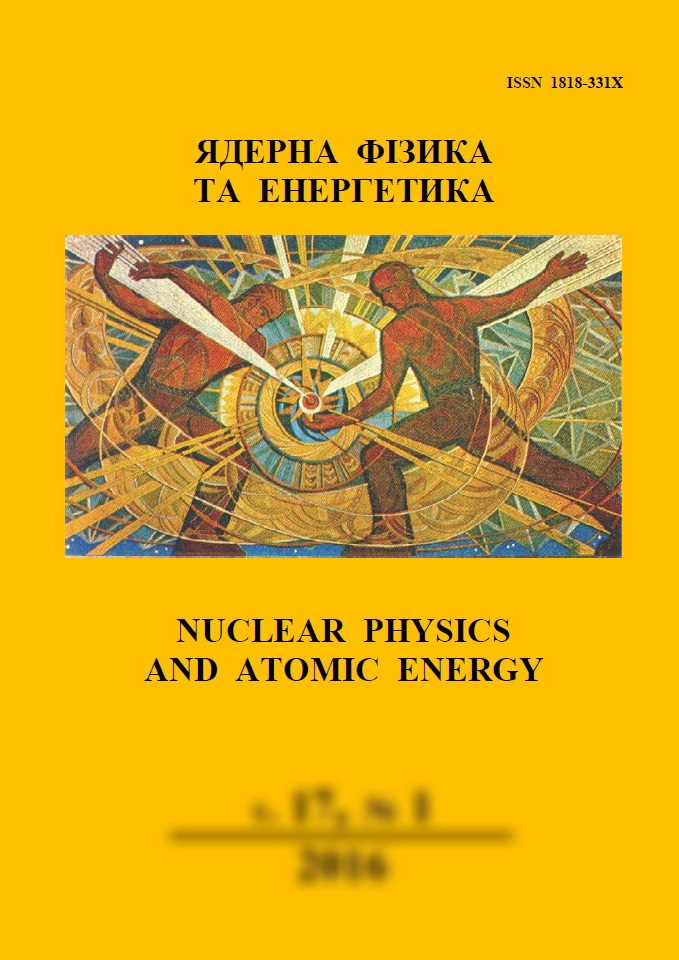 |
Ядерна фізика та енергетика
Nuclear Physics and Atomic Energy
ISSN:
1818-331X (Print), 2074-0565 (Online)
Publisher:
Institute for Nuclear Research of the National Academy of Sciences of Ukraine
Languages:
Ukrainian, English
Periodicity:
4 times per year
Open access peer reviewed journal
|
Nucl. Phys. At. Energy 2003, volume 4, issue 1, pages 167-175.
Section: Engineering and Methods of Experiment.
Received: 13.11.2002; Published online: 30.03.2003.
 Full text (ru)
Full text (ru)
https://doi.org/10.15407/jnpae2003.01.167
Influence of the electrophysical radiation processing on the shelf-life and nutritious properties of meat
M. I. Bazaleev, V. F. Klepikov, V. V. Lytvynenko, I. М. Sharkevich
State Enterprise "State Scientific and Technical Center for Nuclear and Radiation Safety" of the National Academy of Sciences, Kharkiv, Ukraine
Abstract:
The data on absorbed doses and sterilization regimes for meat products, providing toxicological
safety and high effectiveness of irradiation processing, are presented. Recommended absorbed dozes for
meat sterilization eliminate pathogen bacteria effectively in accordance with the international rules for
microbiological control. Sterilization technologies in oxygen free atmosphere are described. We discuss
quantitative and qualitative methods for control of absorbed doses, as well as postirradiation control to
determine the presence of irradiated food.
References:
1. Базалеев Н. И., Клепиков В. Ф., Литвиненко В. В. Электрофизические радиационные технологии (Харьков: Акта, 1998) 206 с.
2. Кодекс основных стандартов радиационно-обработанных пищевых продуктов и рекомендательный международный кодекс по практике работы на радиационных установках, использующихся при обработке пищевых продуктов. Кодекс по вопросам продовольствия. Том ХV. Объединенная программа стандартов ФАО-ВОЗ на пищевые продукты (Рим, 1984) 24 с.
3. Beuchat L. B., Doyl M. P., Bracket R. E. Irradiation inactivation of bacterial pathogens in ground beef (Univ. of Georgia Center for Food Safety & Quality Enhancement report to the American Meat Institute, 1993) p. 17.
4. Diehl J. H. Nutritional erffect of combining irradiation with other treatments. Food Control 2 (1991) 20.
https://doi.org/10.1016/0956-7135(91)90114-C
5. Kilkast D. Effect of irradiation on vitamins. Food Chemistry 49 (1994) 157.
https://doi.org/10.1016/0308-8146(94)90152-X
6. Dubey J. P., Thayer D. W. Killing of Different Strains of Toxoplasma gondii Tissue Cysts by Irradiation under Defined Conditions. J. Parasitology 80 (1994) 764.
https://doi.org/10.2307/3283255
7. Greenberg R. A., Tompkin R. B., Bladel B. O. et al. Incidence of Mesophilic Clostrodium Spores in Raw Pork, Beef, and Chicken in Processing Plants in the United States and Canada. Applied Microbiol. 14 (1966) 789.
https://doi.org/10.1128/am.14.5.789-793.1966
8. Krieger R. A., Snyder O. P., Pflug I. G. Clostridium botulinum Ionizing Radiation D-Value Determination Using a Micro Food Sample System. J. Food Science 48 (1983) 141.
https://doi.org/10.1111/j.1365-2621.1983.tb14808.x
9. Lambert A. D., Smith J. L., Dodds K. L. Combined Effect of Modified Atmosphere Packaging and Low-Dose Irradiation on Toxin Production by Clostridium botulinum in Fresh Pork. J. Food Protection 54 (1991) 94.
https://doi.org/10.4315/0362-028X-54.2.94
10. Smith J. L., Dodds K. L., Charnodeau R. Microbiological changes and shelf life of MAP, irradiated fresh pork. Food Microbiol. 9 (1992) 231.
https://doi.org/10.1016/0740-0020(92)80051-5
11. Maxcy R. B. Significance of residual organisms in foods after substerilizing doses of gamma radiation: A review. J. Food Safety 5 (1983) 203.
https://doi.org/10.1111/j.1745-4565.1983.tb00471.x
12. Dempster J. F., Havrysh Z. J., Shand P. et al. Effect of low dose irradiation (radurization) on the shelf life of beefburgers stored at 3 °C. J. Food Technology 120 (1985) 145.
https://doi.org/10.1111/j.1365-2621.1985.tb01912.x
13. Lefebvre N., Thibault C., Charbonneau R. Improvement of shelf life and wholesomeness of ground beef by irradiation. 1. Vicrobial Aspects. Meat Science 32 (1992) 203.
https://doi.org/10.1016/0309-1740(92)90107-F
14. Lefebvre N., Thibault C., Charbonneau R., Piette J. P. G. Improvement of shelf-life and wholesomeness of ground beef by irradiation - 2. Chemical analysis and sensory evaluation. Meat Science 36 (1994) 371.
https://doi.org/10.1016/0309-1740(94)90133-3
15. Chuaqui-Offermanns N. Recent advances in the identification of irradiated foods of animal origin. A review. J. Radiation Sterilisation (1992) p. 29.
16. Glidewel S. M., Deighton N., Goodman B. A., Hillman J. R. Detection of irradiated food: A review. J. Sci. Food & Agric. 61 (1993) 281.
https://doi.org/10.1002/jsfa.2740610302
17. Schreiber G. A., Helle N., Boegl K. W. Detection of Irradiated Food—methods and Routine Applications. Int. J. Radiation. Biol. 63 (1993) 105.
https://doi.org/10.1080/09553009314550141
18. Stevenson M. H. Identification of irradiated foods. Food Technology 48 (1994) 141.
19. Morehous K. M., Kiesel M., Ku Y. Identification of meat treated with ionizing radiation by capillary gas chromatographic determination of radiolitically produced hydrocarbons. J. Agric. & Food Chem. 41 (1993) 758.
https://doi.org/10.1021/jf00029a015
20. Review of the safety and nutritional adequacy of irradiated food: Report of a WHO concultation (WHO, 1992).
